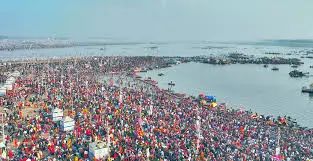Maha Kumbh 2025 Concludes with Mahashivratri Snan
Amid chants of "Har Har Mahadev", a multitude of pilgrims from across the country and abroad took a holy dip at the Triveni Sangam on Mahashivratri as curtains came down on the 45-day Maha Kumbh, billed to be the biggest gathering of people in the world, on Wednesday with the final "snan".

New Delhi: Amid chants of "Har Har Mahadev", a multitude of pilgrims from across the country and abroad took a holy dip at the Triveni Sangam on Mahashivratri as curtains came down on the 45-day Maha Kumbh, billed to be the biggest gathering of people in the world, on Wednesday with the final "snan".
The Maha Kumbh that had started on January 13 on Paush Purnima ended on Shivratri with over 65-crore pilgrims taking a dip in holy Triveni Sangam waters in Prayagraj. On the last day, close to 2-crore people took a dip in the holy waters. The Indian Air Force conducted an air show. According to the Uttar Pradesh government, 64.77 crore people have visited Prayagraj since January 13.
Being the last auspicious snan of the Maha Kumbh, a large number of devotees had begun to gather on the banks of the Sangam from close to midnight, and while some camped and waited patiently to take the dip at the "Brahma Muhurt", scores of them performed the bathing rituals much before the appointed time. As devotees took a dip, helicopters showered flower petals.
Uttar Pradesh chief minister Yogi Adityanath has been monitoring Wednesday's snan. In a post on X, the CM said, "Hearty congratulations to all the revered saints, Kalpvasis and devotees who have come to take a holy dip in the Triveni Sangam today on the holy bathing festival of Mahashivratri dedicated to the worship of Lord Bholenath in Maha Kumbh-2025, Prayagraj...Har Har Mahadev!"
The mega religious carnival wound to a close in a montage of images of the stampede that killed at least 30 people. The devouts across every spectrum took a dip; huge crowds jostling not just at the Sangam but also at stations and bus stands were seen. Political slugfest over "contested numbers" of devotees and how clean the waters were also played out in full public view.
Maha Kumbh, which takes place once in 12 years, saw grand processions of Naga Sadhus and three "Amrit Snans". Over the 45 days period, the Maha Kumbh witnessed six special bathing dates -- Paush Purnima on January 13, Makar Sankranti on January 14, Mauni Amavasya on January 29, Basant Panchami on February 3, Maghi Purnima on February 12 and Mahashivratri on February 26 -- including three Amrit Snans.
The mega event saw its share of happy and sad moments, with the stampede tragedy overshadowing the spiritual mood at times. It was the second Amrit Snan on January 29 when chaos and tragedy broke out. The stampede near Sangam banks, leading to 30 deaths allegedly due to overcrowding. The tragedy triggered a political slugfest with West Bengal chief minister Mamata Banerjee slamming the Yogi Adityanath-led government to say it was a "Mrityu Kumbh" and the BJP hitting back. The Samajwadi Party and the Congress accused the Yogi Adityanath-led government of concealing the stampede toll.
Yet the undaunted spirit of devotees did not get affected. President Droupadi Murmu, vice-president Jagdeep Dhankhar and Prime Minister Narendra Modi were among the dignitaries who took a dip in the holy waters. Besides them, a whole lot of business leaders like Mukesh Ambani and Gautam Adani’s families, widow of Apple founder Steve Jobs Laurene Powell Jobs, film stars, envoys of various countries posted in India, NRIs and people from India and abroad, including neighbouring countries like Nepal, took a dip in Sangam waters.
Given the scale of the event and the sheer volume of attendees, authorities had to enforce a "no vehicle zone" in the mela area and Prayagraj, besides implementing strict crowd control measures and logistical support to facilitate a seamless culmination of Maha Kumbh. The stampede on January 29 prompted the state administration to restrict the movement of vehicles near ghats, forcing people to walk several kilometres. Better crowd management was set up to prevent more such tragedies from taking place.
The rush in Prayagraj was unprecedented causing kilometers long traffic snarls and diversions. At one point in time, the roads had to be shut and police of neighbouring states had to request pilgrims to return as the Prayagraj had no space to accommodate more people. The rush led to an increase in flight ticket prices and a rush in trains, leading to a stampede at Delhi railway station despite Indian Railways running extra trains to beat the rush.
